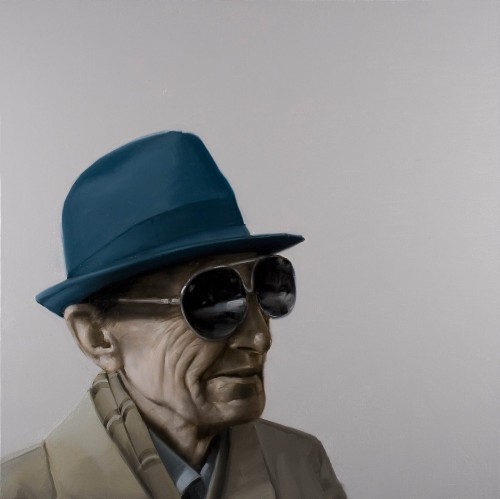
Mircea Suciu
“Our capacity for imagination defines us as precisely as our power of speech. In order to be able to cope with tomorrow I have to create, today, however briefly, an image of the world I am about to enter.”
Anthony Pagden
“Without exile, without nostalgia for the lost country, I do not think I would be a writer.”
Isabel Allende
“And therein lies one of my fatal mistakes in life. Just a few days ago I wrote a note to myself; ‘always, even in moments of fulfillment, your tendency to think: its not here yet! You always experience even the most perfect present moment as mere advent. You always expect something more afterward, something bigger, the ultimate.”
Peter Handke
“My Year In No Man’s Bay”
It is ever more alarming to examine the political landscape today, the sheer horrors of U.S. foreign policy. And now, Saudi Arabia will head up and chair a panel of experts on human rights for the U.N. As Felicity Arbuthnot noted, perhaps that should be ‘behead’ a panel. In any event, these low comedies of Empire are akin to the days of the Raj or King Leopold. The U.N. has found a new bottom and that wasn’t easy. Saudi Arabia is, of course, in the process of obliterating the nation of Yemen. The bombings have killed hundreds of children, putting the House of Saud in competition with Israel for title of worlds leading child killer.
I wrote last week about American cop shows and the reactionary perspective of 99% of them, and also the increasingly bloodthirsty appetite of American audiences, so it seems. But one of the things I feel compelled to keep thinking through is the relationship between a barren strip-mined inner life, and the inability to actually experience the world, and the growing sense of fascist aesthetics. Now, I’m not surprised when an Owen Hatherley writes his fascination (approval) of fascism and advertising (and in theory, architecture) for Architectural Review, but it is more disturbing to see the emergence of fascist taste and values happening in unconscious ways, happening as a product of constant training and conditioning by this hegemonic system of marketing and entertainment.
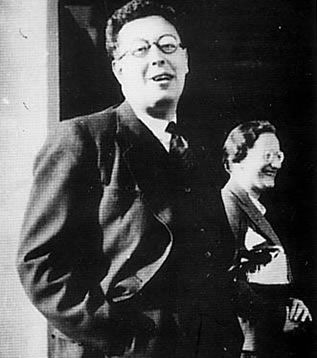
Otto Fenichel
I have a friend who quoted playwright Lauren Gunderson, at a recent symposium of theatre artists — and while this is hearsay in a court — I suspect Gunderson wouldn’t deny it — telling students an MFA was crucial to being a playwright, because after all you wouldn’t let a dentist who hadn’t been to school, then work on your teeth. So there you have it, art as dentistry. But as I say, this should not be surprising. If anyone has ever been around these institutional theatre brie and Chablis *events*, the sheer paralyzing boredom and numbing mediocrity of these people is enough to send one off screaming into the night.
So fascism and dentistry.
What is at issue here, I think, is something Terry Eagleton wrote about over twenty years ago, and that is the linkage between ideology and aesthetics. But I will return to this below. First I wanted to look at the origins of psychoanalysis.
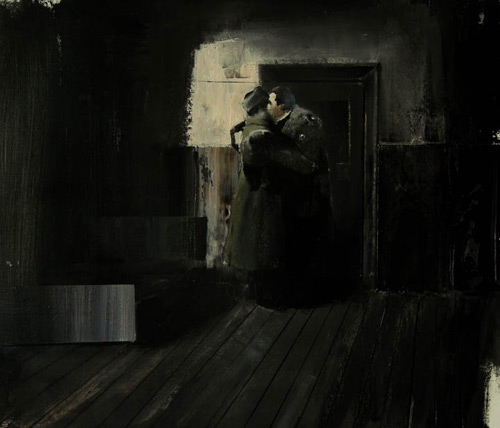
Adrian Ghenie
One of the forgotten aspects of cultural life, or forgotten historical perspectives on culture, is connected to that period in Europe (primarily Germany and Austria, though Hungary, too, and the former Czechoslovakia, and even Switzerland) from the late 19th century until, say, 1900 and a bit after. Russell Jacoby described this as the ‘culture of psychoanalysis’, and what he called the spiritual atmosphere of that period. The rise of National Socialism severed this cultural atmosphere from the practice of psychoanalysis, but also, by extension, from the spiritual atmosphere surrounding art and architecture. As Jacoby points out, events in living memory are less secure than distant happenings. Even if this is not entirely true, in this particular case I think it is true. The radicalism of first and second generation psychoanalysts is all but forgotten. That Otto Fenichel was, as an example, both politically and socially radical, is almost unknown to students today who read his work. The political underpinnings of thinkers such as Fenichel, or Edith Jacobson and Henry Lowenfeld, or Ernst Simmel, is no longer seen as relevant to their work. This erasure of historical context, and really, of the political agenda of these thinkers is similar to the wholesale removal of context, today, for almost all of culture. Art is dentistry, after all.
“When American psychoanalysis embraced a neutral clinical theorizing, it simultaneously became inhospitable to cultural and political psychoanalysis…the repression of the political Freudians and the repression of psychoanalysis itself is the same story.”
Russell Jacoby
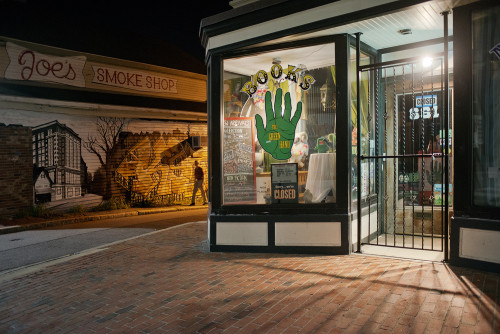
Lynne Saville, photography.
The socialist writings of Fenichel are omitted from his collective writings, and much of the material in the Freud Collection at the Library of Congress is locked until the twenty second century. One might wonder at the reason for this. Almost all of the first generation of psychoanalysts and many of the second generation were Marxists and were politically socialists. It is worth noting, too, how many women were involved in those first two generations of thinkers. In fact, they constituted perhaps a majority of the circle around Fenichel. The rise of fascism served to destroy history then, and it has continued to repress radical thinking today.
The contraction of psychoanalysis and its cleansing, is part of the climate of specialization, the invention of a secret language and priest class or expert, those with medical degrees and who are initiated into an exclusive circle of highly paid professionals. This is mirrored in, as another example, the MFA mafia of theatre arts, or fine arts in general, today. In the U.S. Artists are discouraged from political involvement, unless they are movie stars, it seems. The current pharmacological imprint of medicalized psychoanalysis would have been unthinkable to that first generation of socialist practioners. The Americanization of psychoanalysis was accelerated by the insecurity of the immigrant thinkers who knew that keeping a low profile was their best chance for personal survival. The avant garde in European arts came out of much of the same spiritual atmosphere as psychoanalysis, and it came from roughly the same period. And there was an enormous erotic energy that infused art and theatre, and even early German language film, and psychoanalysis. In fact, Freud’s break with Jung was partly to do with Freud’s view that the Swiss psychoanalyst was resistant to the idea of sexuality as a force permeating society.
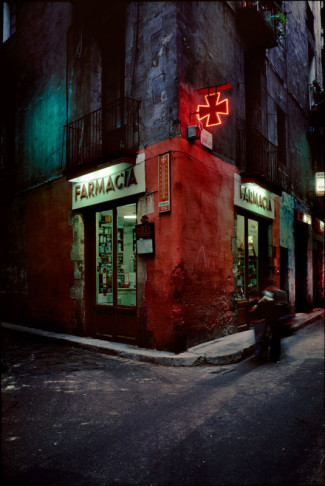
Kizuo Kitai, photography.
Jacoby touches on the Otto Gross story, and indeed Gross was the Artaud of psychoanalysis, and precursor to Reich. Gross was imprisoned in an asylum by his criminalogist and authoritarian father. In this, his story foreshadowed the world to come. It is also of interest to see the durational gaps between youth-movements and fascism. If the fin de siecle was followed three decades (and change) later by Hitler, the 60s in the U.S. might be seen to be followed by 21st century authoritarian Imperialist domination by the U.S. Its not precise, but it’s certainly not imprecise, either. The Berlin Institute of the 1920’s was the endgame for radical psychoanalysis. Fenichel, Karl Abraham, and Ernst Simmel (perhaps the most socialist of the entire group), formed the core teaching unit, and later, at the end of his life, Simmel linked up with Adorno and Horkheimer in California for a conference on ‘anti-Semitism’. Jacoby’s study The Repression of Psychoanalysis, is crucial to seeing the socialist and radical nature of early psychoanalysis, and to understand the revisionist attacks on Freud and the others — especially, often from white academic feminist circles today, as oddly the result of the erasure of the early political commitments of Freud’s circle, and the number of remarkable and radical women involved. And especially to grasp the evolution of the Berlin Institute, and the effects of the rise of fascism in interrupting the project of psychoanalysis as it existed at that time. And worth noting that Simmel in particular desired the Berlin Institute to provide therapy to other than *rich* neurotics. Simmel and Max Eitingon wrote specifically about the loss of proletarian voices at the institute. There is another sort of revisionist literature out there, contra Jacoby (and common sense) that suggests Bernfeld, Simmel, Fenichel and others simply ‘fell in love with America’, and hence abandoned their radical left wing activism. But then, such revisionism is to be expected. Both Wilhelm Reich and Fenichel were later horribly disappointed by Soviet hostility to psychoanalysis. It would be a useful subject to explore in fact, at what point the Communist state turned hostile to a disciple they initially embraced. But certainly none of that first generation of psychoanalysts ever ‘fell in love with America’.
After WW2, the residual radicalism of that first generation was eclipsed by the bureaucratization and medicalizing of psychoanalysis, and in the persons of Karen Horney, and even Fromm (once associated with the Frankfurt School, even) and Menninger, the spiritual atmosphere of Berlin and Prague had become the conformist and anti communist paranoia of McCarthy’s America. Fenichel felt strongly that the essential core truths of Freud were being lost. And with them the radical political agenda of that first generation. Fascism forced the first generation underground, in a sense. Survival itself was in doubt, and if survival meant to subduing their Marxist side, then that’s what it would take. Freud himself always loathed the U.S., and so did Fenichel. Fenichel also noted what he found a curious anti-intellectualism in the U.S. A distrust of big words and of theory. And I think this segues back to Eagleton and the arts. I find today, certainly, an enormous distrust of theory, unless it is part of an academic exercise and removed from daily life.
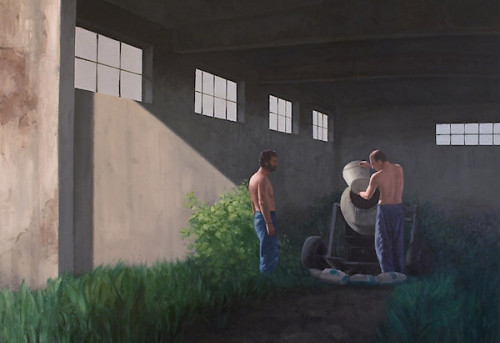
Serban Savu
But Eagleton points out that the meaning of *aesthetics* was originally meant to be that realm of experience outside conceptual thought. It was the immaterial world, the hidden but still experiential side of existence. And this idea of aesthetics has a quality of resistance to it. As Eagleton says, there are ‘intricate relationships between monopoly capital, myth, and modernism’. The solidifying of bourgeois rationalism and Capitalism at the end of the 19th century saw a reaction in the form of a re-introduction of myth, or a new myth anyway. Now however one wants to define *ideology*, the general idea has to do with the manufacturing of meanings and values, usually used in accordance with a specific social group, and in order to sustain the power of that specific group, or at least its legitimacy. Frank Kermode, someone I never tire of reading, wrote a cogent critique of Eagleton’s book on Ideology. He identified the key element in Eagleton as being “…the stark polarities of early bourgeois society gave aesthetics a new philosophical importance; the work of art came ‘to the rescue’ of a commodified existence, equipped with everything in which the commodity is so lamentably lacking – a form no longer indifferent to its content but indissociable from it.” This is also exactly, from another approach, what Adorno claimed as crucial in artwork.
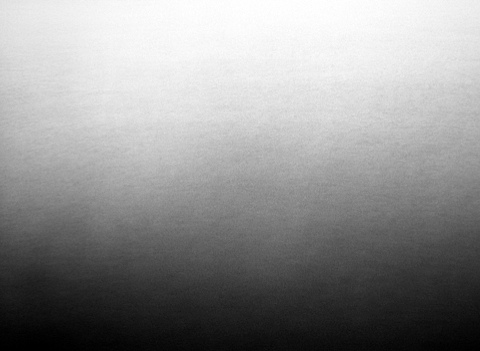
Thomas Joshua Cooper, photography.
Kermode goes on to say; “It isn’t enough to show that the aesthetic is simply ‘bourgeois ideology’, to be peremptorily got rid of and replaced by ‘alternative forms of cultural polities’. Of course it is bourgeois ideology: but it is also part of that achievement of bourgeois revolution which Marx said must be cherished if the socialist order of the future is not to be ‘closed, illiberal’. So although the Enlightenment concept of aesthetic autonomy served the interests of bourgeois individualism, it nevertheless remains ‘a vision of human energies as radical ends in themselves which is the implacable enemy of all dominative or instrumentalist thought’. Out of this contradiction there can be an emergence, at a higher level, of human particularity, a higher notion of the subject, based on a recognition of the autonomy of the other: a development, via the dialectic, of that in some ways very selfish bourgeois invention.”

Edith Jacobson
For Freud, aesthetics were crucial, as they were for Marx. The radical nature of Freudian thought resides exactly in his reliance on ideas such as myth, metaphor, allegory, play, staging, and fantasy. Without saying it directly, Lacan sensed acutely the theatrical as it was embedded in Freud. The human, for Freud, is flawed and ambivalent — and unrelentingly strange. What Freud suggested, beyond all else, was that daily life is very peculiar and that part of the repression upon which society is based has to do with denying this strangeness and peculiarity. Freud was not a particularly good aesthetic critic, his psychoanalytical deconstructions are far less interesting than his anthropology and pure theory. But he was a brilliant stylist of prose. The elegance of his writing is not pointed out nearly enough. But Freud never romanticized the aesthetic; he did however, like Marx, discover the hidden and understood the mechanisms of concealment that are the nature of civilization. The hidden, the source of searching, the focus on things that society has taught itself are not important, is the source of creativity. Today, teaching searches for very little. Art is dentistry. The emphasis is on what CAN be taught, what is marketed as self evident.
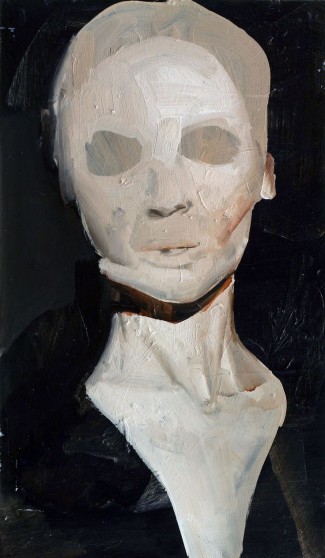
Nicola Samori
Eagleton says “there is a substrate in the unconscious which can never by symbolized”. And the human remains, to some degree, alienated from his ability to speak and write. Language ‘is’ alienation. Partly. The ego is a bodily ego. But the unconscious is not a thing, it is our very existence, the process that shadows all activities — and its been disfigured in the process of being born and maturing. It is our self haunting. The infant only grasps its desire of the object when the object is lost. This is the Lacanian insight. And so the psyche is always following after a lack. Our pleasures are fleeting. How this impacts both aesthetic and ideology is where certain political implications arise.
Contemporary consciousness in the U.S. is one of blandness and obsessiveness. Odd as that may sound. Obsessive banality is another way to put it. Obsessive repetitive triviality.
It may well be that post WW2 America’s most significant social action was union submission vis a vis the auto industry. Unions giving up iron clad control of the work floor, the shop, for what was in theory security. The steel industry, too, to a lesser degree. It turned out to be nothing of the sort, though. For the most significant aspect to that submission (if that’s what it was and I think it was) was that it signaled a real break with traditional patterns of community and family and neighborhood relationships. And that erosion distanced labor’s radical oppositional stance toward ownership. Of course this foreshadowed the total destruction of unions under Reagan thirty years later. So, labor’s hostility to management lessened, as it was also under bombardment from the increasingly powerful media, at the same time as those first generation psychoanalysts had gone into metaphorical hiding. Critique softened throughout the society. As Steve Fraser points out, the domesticating of resistance to Capital has been shaped by conscious media propaganda — featuring ideas like *freedom*, when what is meant is freelance job insecurity. Individualism is now beat on constantly because it mystifies the loss of union solidarity and organizing. In Hollywood, unions are depicted as something from the past. Unions are always in narratives set in the mid century or before. The implication is the very idea is antiquated. The aesthetic dimension was aligned with cold war anti communist hysteria. Conformity meant solidarity, but solidarity with Capital, not against it. Not with fellow workers. Anything smacking of Marxism or Bolsheviks was anathema. This signaled the beginning of the cleansing of context for entertainment. And for PR and the state. Then, post Reagan (and really, before) the financialization of capital began. The new underclass grew exponentially. And entertainment became geared to stultify the mind. And was increasingly open about it. Escapism became an acceptable idea, which when one thinks about it, is rather staggering.
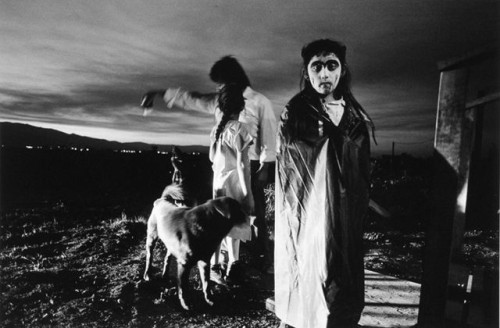
Eniac Martinez, photography.
“…anxious consumers could also imagine themselves as independent producers, reassured by ‘the fable of the free agent’ that redefines perpetual insecurity as freedom. Aspiring free agents shared with their bosses the illusion that ‘the means of production could be somehow downloaded from complex organisations to anyone owning a computer’, that technology was dissolving the old material forms of class oppression.”
Jackson Lears
The admission that people feel the need to escape is sort of profound. Escape from what? From your conscious life? In a sense the answer is yes. And this is where the loss of aesthetics and mimesis figures in. But it is also interconnected with ideology. One is mimetically narrating one’s life. You could say ‘interpreting’, too, and the meaning is very close. But ideology works not by creating a criteria of truth or untruth — but by directing the focus of interpretation. And that process of directing, or choosing what to interpret, and more, how to interpret, is what ideology does. Religious fanatics ‘interpret’ a leaf falling from a tree as a sign from God. The leaf did fall from tree, but the scientist will tell you it was because of wind, seasonal processes and the plants need to shed old leaves in order to protect the tree or plant from the harsh cold air of winter. But ideology has a functional aspect, as Eagleton (and Raymond Guess) point out. Certain observations are collected in groups, and they are employed as arguments for sustaining relationships of power and authority. In a way, all authority is ideological. So, like the gradual erosion of Union strength in the U.S., the effectiveness of ruling class propaganda had to do with the working class having just enough cultural literacy to be controlled by ideological means. It was Lenin, after all, who said the revolutionary proletariat in Russia saw more clearly their relationship to the ruling class. But that this same lack of cultural literacy made sustaining the revolution harder. The inverse would be true of the West. Marx said that as markets became more complex, social relations became more obscured. Adorno placed great emphasis on the obscuring of reality in the late capitalist society — and the production of new social realities (ideological illusions). Of course, he knew also that he, like everyone, was functioning from within an illusion, was also aliented and tied to language.
“It is with Gramsci that the crucial transition is effected from ideology as ‘systems of ideas’ to ideology as lived, habitual social
practice – which must then presumably encompass the unconscious, inarticulate dimensions of social experience as well as the workings of formal institutions.”
Terry Eagleton

Anita Molinero
The question of aesthetics then — and with Freud’s ideas on the unconscious — are ultimately about experience. Now, looking at the U.S. today, there is a reason for the constant and seemingly never ending drum beat of electoral politics. Voting is the constant reinforcement of the idea of equality. Everyone has a vote, therefore everyone is equal. This is of course not true, however. But the expanding of campaign season ( a bit like the expanding of Christmas shopping season) is serving to keep this illusion foremost in the minds of citizens. The act of voting is then a sort of magic elixir for conveying a sense of equality, and it is coupled with the idea of ‘responsibility’. It also reinforces a binary view of the world. But then, as Eagleton points out in a chapter on Adorno, this is what exchange value also does. And this is where aesthetics intersects to release us from the tyranny of exchange value. But there is another aspect here, before getting further into aesthetics, and that is the effects of the Enlightenment. Of instrumental reason and logic. And again, this is where Freud matters. And where those political Freudians in particular matter. The artwork steps outside instrumental reason and the experience of the artwork is not logical. It is non conceptual. (which is my problem with concept art). The ideology of neo-liberal Capitalism is one that is inflexible and narrows experience, and really, in its exchange value form, tends to deny the unconscious. Most people living in the West today would argue with this because their ideological attachment or identification is with their own sense of personal autonomy and freedom. And that freedom is synonymous with shopping. With owning ‘things’.
“In psychical life, a mere concentration
on what Freud calls the ‘manifest content’ of the dream will blind us to
the ‘dream work’ itself: where the forces of the unconscious are most
stealthily operative. Both dream and ideology are in this sense ‘doubled’
texts, conjunctures of signs and power; so that to accept an ideology at face
value would be like falling for what Freud terms ‘secondary revision’, the
more or less coherent version of the dream text that the dreamer delivers
when she wakes. In both cases, what is produced must be grasped in terms of
its conditions of production; and to this extent Freud’s own argument has
much in common with The German Ideology. If dreams cloak unconscious
motivations in symbolic guise, then so do ideological texts.”
Terry Eagleton
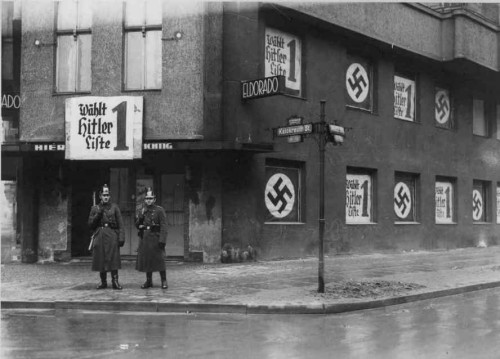
El Dorado Club, closed by Nazis. Berlin.
The instability of the self, as a construct, becomes increasingly exposed under capitalism. It requires more and more ideological training. And contemporary society can barely keep up with demand. What Jacoby called the ‘Americanization of psychoanlysis’ was really just the imprint of an ideological scientism on the once radical theory. Psychoanalysis was being re-purposed into an ideological system in service to the Capitalist state. And the fact that psychoanalysts participated in illegal brainwashing and torture during the Iraq invasion and occupation, suggest the truth of this. Learn to adjust became the mantra. Make your life work. (Here life was being equated with a working machine). The new professional class absorbed psychoanalysis and neutralized the radical political implications. I wrote last post about the U.S. TV cop franchises and how the backdrop was always one of *crime control*. In a sense that containment and control operates at the theoretical level, too, and certainly in terms of psychoanalysis is has been hugely effective. In Freud, the unconscious wish seeks expression, but the ego contains and neutralizes, in a sense anyway, and this is the constant tension of society, and it is also the constant dream work of the individual — everything is being exposed, or it is being hidden, or both. The problem is that ideological illusion is not some *thing* that is removed like ray-bans, it is a tension, a contradiction, and in contemporary Western society the *imaginary* (in Lacanian sense) would suggest exactly the course, the logical course, that capitalsm has taken via electronic media, via the ever more pervasive screen world, and ever more contracted ownership class. The missed appointment of Lacan is to be expected. Aesthetics, in the most originary sense, is a revealing of self, of self as body, as mimetic, and hence it is — to stretch this metaphor — scaling the outer walls of the containment area. As police today ‘kettle’ protesters into *free speech zones*, so the psychic mechanisms of conformity shrink the self in a tiny narrow bland colorless, ordorless, box of experience. The off campus influences are throwing rocks from….somewhere out of sight, in the shadows. That is the artwork.

Marius Bercea
Today, the narrowing of experience is ratified by a system that increasingly manufactures a social reality of constant movement. But it is distracted movement, and in Hollywood now even rural landscapes feel urban. It was Benjamin who suggested urban experience was a mix of amnesia and forgetfulness. But Benjamin believed distraction itself was a kind of skill — an optimistic view that Adorno disagreed with strongly. But it is this new bland ever moving urban-ish kettled zone of the psyche that allows for a bloodness sense of *fun*, or that which is not happiness. Entertainment and fun are identical, really, and bodiless. I’ve asked before what the verb *party* means in contemporary society. To *party* …. presumably means get fucked up. It is like counterfeit Dionysian release. Except it is more about the forgetting than the experiencing. The aestheticizing of the political, attributed to fascism, in the sense of spectacle and rallies and uniforms, is replicated now in diffuse semiotic codes. The mass rallies of the Nazis are now reproduced in miniature as ironic style codes, or *lifestyle* choices. Eating craftsman heritage popcorn and artisanal yogurt, and wearing an ironic tie or shirt is the shrunken eviscerated aesthetic capacity of the modern urban dweller. The experience is shallow and intellectual. And conformist by default.
There is one other related topic, I think, that sort of links up with ideology, the repression of psychoanalysis, and with aesthetics. In the early Freud, in a letter from 1896 to Fliess, he wrote “the prehistoric, unforgettable, other person who is never equalled by anyone later.” This was in relation to seduction theory, and trauma. John Fletcher has a very keen take on this, citing Jean Laplanche, and observing that the English translation of this temporal sequence Freud was postulating was ‘deferred action’. Which reduces the meaning. Laplanche chose the literal ‘afterwardsness’. Now, without getting too far into seduction theory, it does relate to the instability of the self, and to memory. For memory is perhaps the most significant of keys to recuperating the artwork from mimetic muteness and triviality. The traumatic first event is not able to be assimilated and so it repeated and repressed– but repeated in a series of secondary scenes. The repeating is, itself, traumatic, too. These scenes are superimposed on each other, revised, overdetermined, and in a sense are submitted to new sceneography. A new mental set designer is employed. A new actor, often, too. Charcot liked, as Fletcher points out, the metaphor of ‘agent provocatuer’ for the releasing agent of the symptom. Freud also described, at that time, the adult hysteric using voices “as if from a phonograph”. The ventriloquist metaphor is one I happen to like, but the point is that the fictional narrative, the play, the poem, and then, even the painting, or the film, are voices that remain all our own voice, only pre-recorded. The use of actors, in this light, becomes a very strange phenomenon indeed, but then I’ve always thought acting the very strangest of professions.

Doug Rickard, photography/media.
Theatre then, as I’ve said before, reproduces something primal in the psyche. That empty stage is the landscape of the very young child. The parameters of the world of the pre-toddler, and infant, do not extend very far, and the world essentially enters and exits, on cue from the primal narcissist director. Except of course gradually the actors are late picking up their cues, or they just don’t show at all. The tragedies of Greek drama remain so compelling more because of the sense of space in Greek drama, than because of the stories. The myths are certainly significant, but more so the idea of such myth when situated in our own private performative arena. The myth is activated by way of a reproduction of mirrored space — which may well be partly what myth always is.
Fletcher remarks that Freud’s early comments on Oedipus Rex reflected his sense that the dramaturgy of the play was much like the work of psychoanalysis. That Oedipus is the author of his actions, which have already taken place in the past, before the play begins. This is a remarkable observation, actually. For it reveals something significant about all theatre. I’ve said before that when the curtain raises (or lights come up), there is a sense that something has just left the stage. Narrative is then more about uncovering the past — then chasing the wishes of the future — even though everyone always does both. And the audience and author both share this multiple emotional engagement. The fulcrum for the story is when Oedipus cries “what a profound distraction has seized my mind”. He is literally at the crossroads. The actor must, as the play begins be aware of these conflicting energies — the past and the future. The performance is always caught in that tension, and the crossroads is that place where one meets the ‘other’, or doesn’t. It is also the site of the missed appointment. Joyce McDougall, whose most important book is titled “Theatres of the Mind”, sees psychoanalysis inextricably linked to theatre, and the ego is both actor, director, and audience — in (as Samuel Weber puts it) a ‘secret intimate repertory company’. This is where I see Adorno’s ideas on mimesis as being quite relevant for we are always silently composing a parallel story to the one before us. And in that process of composition resides this private and secret rep company. Freud’s case of ‘Dora’ is very close to Sophocles in that as she admits “I knew it all the time”, but had just “never thought of it”. So, too, per Samuel Weber, is it with Oedipus. What is it that is being chased when the lights come up?
“What is striking is that the plot of Oedipus Rex, as that of its sequal Odipus at Colonus, entails virtually no action at all, nothing except a series of speeches, messages, dialogues — nothing in short but language. As for action, whatever is relevant occurs offstage. The murder of Laius, the self blinding of Oedipus. All that is shown onstage are the *effects* of these acts, never the acts themselves.”
Samuel Webber
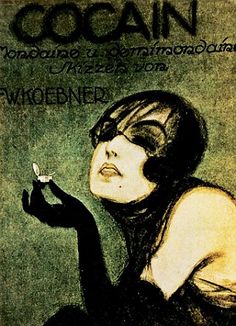
Poster advertising Cocaine, Berlin 1920s.
What we are chasing is the play itself. The desire for completion, which is the engine of all narrative. But this is the story of our own trauma, our lack, our missed appointment. And when the play ends, the secret rep company must repeat it, again and again. And it is in this discussion that questions of place and action start to blur. And to return to Freud, this is also much like dreamwork. ‘Who’is dreaming? It is not the person remembering the dream. The person re-telling the dream was also the audience for the dream, as well as dreamer, and the actor. Nothing is complete, or unified.
The contemporary individual does not process a world that contains metaphor or allegory. It is a world of common sense, of science, of logic and of definitions, and the pretense of completion. And the rise of humor is the pressure valve for the suffocating homogeneity of modern life now. Irony, and infantile humor is constantly available but the laughter is nervous and even anxious. It doesn’t matter if its funny…laugh anyway. Because you can laugh, you had better laugh. But nothing is really funny. The same as nothing is really tragic. The mechanisms of Capitalism tend, always, to defuse the radical voice. They defuse and then bury or exile it. The vast majority of pop cultural product is devoutly one-dimensional. And you should take note, when a legitimate metaphor actually appears, by accident, it is quickly stripped of its concrete reality by the writer. It is always only a dream or a hallucination, and hence, NOT important. A psychic mistake.
In Oedipus, Sophocles introduces civic trauma in the form of plague. It is a plague on fertility. Oedipus flees to a place where he says, he will not have to see the prophecy come true, but which is a place of deep uncertainty, and is something very close to the unconscious — it is flight to oblivion and yet it is precise. It is where the roads meet, it is the most overdetermined spot in all of literature and narrative. In Sophocles, the protagonist does not ‘wake’ up from his dream. The dream itself is a form of waking up. It is the most Vedic of tragedies, in fact. The dream dreams us.
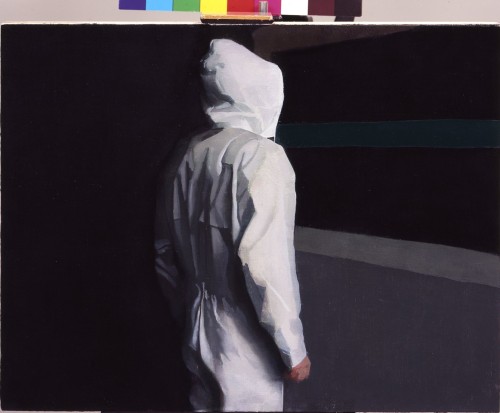
Victor Man
It is interesting to look at the number of painters and artists coming out of Romania in the last several decades. The list includes a huge number of painters that I think are very notable; Serban Savu, Adrian Ghenie, Mircea Suciu, Marius Bercea, Ciprian Muresan, Roman Tolici (born in the former USSR but lives and works in Romania), Cantemir Hausi, Mircea Cantor, Radu Comca, István Betuker, Veres Szabolcs, and Victor Man. That’s a remarkable number. It is suggestive of something, and if one looks at the work of, say, other former Eastern bloc countries it does seem disproportionately high. It is disproportionately high period. For any country. Romanian art is now suddenly getting exposure, not unlike the artists that came out of the Leipzig Academy in the former East Germany. The center for Romanian painters is the art academy in Cluj/Napoca. And like Leipzig, there is a rigor that is the residue of communist training (a bit like Polish National Film School, where I taught, in relation to US film schools, or British, or Danish). The echos of Soviet social realism is clear, but it’s also oddly refracted into a normal that’s not normal. A kind of uncanny as a principle. But there is also a sense of the world that feels less reified, somehow. I think if one looks at this work, and it is, in fact, pretty heterogeneous, you do see several things. One is that most of it is figurative, and second, it is like the anti-twee movement. This is clearly not work coming out of the U.S. or U.K. This is generalizing, I know. But there is a distinctly eastern quality to it. Now, I happen to love Romania, and it might well be my favorite country in Europe. Especially Transylvania (where Cluj is located). It is a magical landscape, and the relative lack of tourism and contact with the West (or anyone) for decades perhaps allowed for more inward looking artists. This is figurative work, but it is not empty design. It is not facile or clever, or glossy (metaphorically). It is technically convincing, although hardly is it a builder of virtuosity.
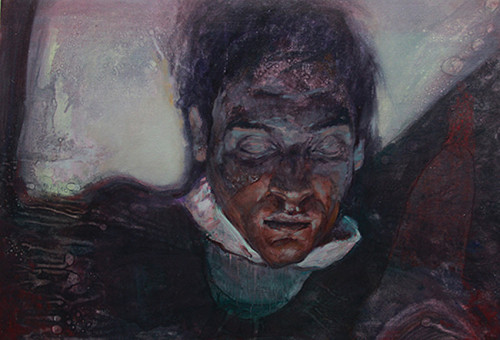
Istvan Betuker
There is a lot of silence in this work, and a quality of surveillance, even paranoia. I was introduced to Romanian art when I first saw Serban Savu’s work, and then Ghenie, who is probably the best known of the Romanian painters. But Mircea Suciu is the latest to suddenly be getting exposure and his work is in some ways quintessential Cluj Art Academy. A sub textual surrealism haunts these works, and there ‘are’ influences, Anselm Kiefer for one, but this work also relates to painters like Alexander Tinei of Hungary (by way of Moldova) and even Luc Tuymans and Michael Borremans, Nicola Samori, or Justin Mortimer, and all of them owe something to Francis Bacon. It is a world of shades, aphotic and stygian — these are subterranean life forms. There is a sense of earth in all of this work, and these are figures who are alone and yet somehow, strangely, not alienated. They are emerging.

Speak Your Mind